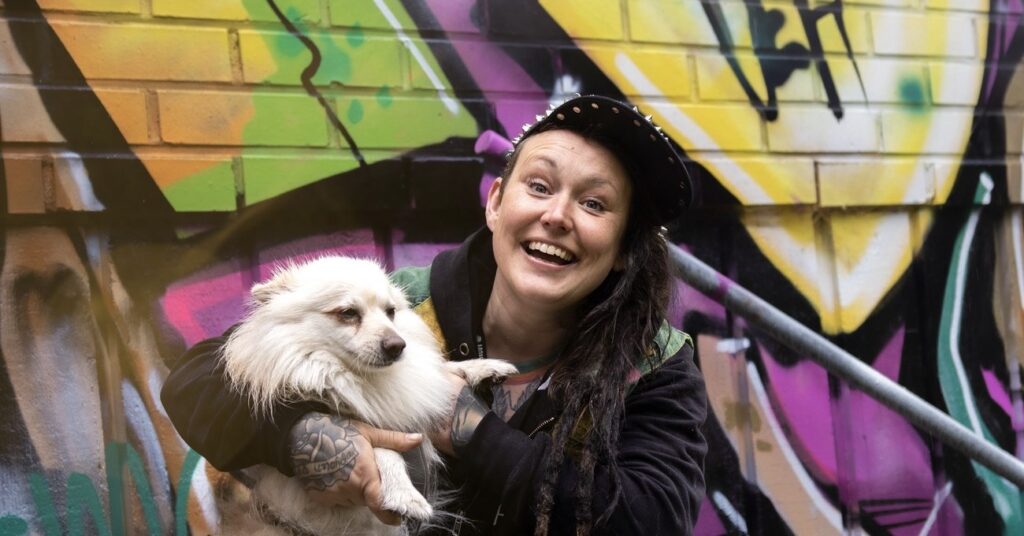In Autumn 2022, sister cities Tampere and Tartu celebrated 30 years of friendship with a programme of events that included a Friendship Mural. The mural brought together youth street art and digital content comprising youth music and poetry.
Behind the design of the 500m2 mural on Tartu’s Sõpruse Bridge and directing the participatory painting process was street art project manager and producer Piritta Suominen from street art association SirkusRakkausPumPum (SRPP) (CircusLovePumPum).
I interviewed Suominen, in person, in her hometown of Tampere in spring 2023.

Piritta Suominen, how did you find your way into the cultural sector?
I’ve always had an active imagination and when I’m playing or doing something I’m unstoppable, so even as an adult, playing with children comes really naturally. There have always been a lot of kids in my life and I’ve enjoyed organising activities for them. My role as an adult has been to create the scaffolding for their play. I have huge range of skills that are not really related to cultural sector work, but they’ve led me to situations and jobs where I’ve ended up doing cultural work
What is SirkusRakkausPumPum and how did it come about?
SirkusRakkausPumPum originated in 2011, inspired by the idea of a 5 year old. It was then that my five-year old decided she wanted her own circus that would travel everywhere and paint the world in rainbow colours, and ask How are you going? and What would you like to play? Everybody would be welcome to join in, from babies to grandfathers, wheelchair users and those without kids of their own. I thought it was a wonderful idea. My child came up with the name (CircusLoveBoomBoom) and put on the first puppet show and said now we’re going on tour. I said let’s do it and organised us an eight-show tour. We went to the grandparents’,visited parks, aged care homes and daycares. It was a performance that invited the audience to join in and to contribute voices/noises, puppets and props. The perfomance also combined role-play and dress-ups.
The following summer, we suddenly had a hundred volunteers doing children’s events. At first, these were families we knew already and together we staged pirate adventures and other workshops – puppet shows, children’s music and theatre activities.
I scripted the workshops based an idea from my hugely prolific child. We even coined a new term: adventure theatre. Last year, the association shifted from organised play to primarily street art. At SirkusRakkausPumPum, our aim – in short – is to offer children and young people meaningful, legal and safe street art activities and, at the same time, discourage vandalism.

So what you’re doing is community art?
Exactly. For a few years we operated as an unregisterd association because at that time it didn’t really feel like we fitted in to any particular sector, and the stuff we were doing didn’t attract funding. It was only later that our approach started to become more common; we moved away from the performer-audience model and invited people of really diverse backgrounds and ages to participate. There was a real need for activities that all parents and their kids would feel comfortable joining in. You need to create something silly that people can throw themselves into, and I feel like we succeeded creating that kind of atmosphere. We had already completed various community art projects, including with the Wheelchair Dancers of Pirkanmaa, when young – childfree – grafitti artists also began to take an interest in what we were doing.
How do you fund your activities?
Our work is funded through various project grants, commissions and wage subsidies. For the latter, rather than just gig workers, we choose individuals who are keen to develop themselves and to further our educational concept and who are able to commit to the various schedules and projects. Street art education is offered with the same enthusiasm and quality everywhere and for all groups.
A large part of our work funded through commisions. Municipalities, cities, art museums, schools, daycares and construction firms contract expert services, street art consulting on choosing the walls, designing the work and designing courses on how to paint.
Among the commissions we have undertaken are MM-kisakatu (World Championship Competition Street) and Tampere City’s Kesäkatu (Summer Street) project which also included participatory workshops.
How did you learn to do graffiti and to teach it?
Just by doing it myself. I don’t have a background in street art or any strict artistic vision or goals. My strength lies, above all, in coming up with the concepts and in the ability to structure the work into appropriate units. I’m a above all a creator and an educator, inspired by people and talent and colours and atmospheres.
How does digitality appear in your work?
During the Covid-19 pandemic, we create a virtual street art map (2020) for Tampere Art Museum (here, in Finnish), showing street artworks, street art parks and legal graffiti spots in the Tampere area. We keep the map updated and anyone can use it, even teachers utilise it in their art education work. There are currently about 150 points of interest on the map and [as of spring 2023] it has been viewed almost 191,000 times. The map has also attracted various social media posts. Beyond the Tampere region, we have also organized participatory street art training elsewhere in Finland, including Oulu and Ostrobothnia. In planning and organising the events, you always have to enlist local social media channels. Bringing people together is a super skill of the future, and digitality is an essential part of this. Young people use Instagram especially, so that’s where we keep them updated using their own language and their own images. We have also received a lot of positive feedback via social media. People also readily offer to get the message out there on social media. In addition to Instagram, we share photos and videos on Facebook, YouTube, via image library and on our homepage.

What else can we do to reach out to young people and get them involved?
In addition to social media, we can engage young people through schools and youth centres. It is easier to engage with young people in smaller communities compared to big cities where there is so much more on offer. It’s a kind of outreach youth work: I talk to the kids and listen to what it is they want. Young people are best at communicating the message to other young people.
Young people need to be involved on an equal footing – as equal participants. In Lempäälä, for example, our first meeting was held at a youth centre and then the young people themselves were given the opportunity to decide the venue for the next meeting. Of course, as organisers, we have an idea of what is possible, but it’s futile as an adult to try and guess what young people will find genuinely engaging. Young people have a good sense of what activities are needed and where. If the adults take over – steering the activities in the direction they feel is clever – the whole thing can become counterproductive.
My approach is also quite spontaneous. Even when we’re already out in the street, painting, I’ll go up to young passers-by and invite them to join in.
SRPP has been running for over 10 years now and has received many children- and youth culture awards. What highlights spring to mind?
We’ve had so many wonderful experiences…one is the summer of 2022, when we were invited, along with street artist Eetu-Elmeri Heino, to join the international scout jamboree in Evo Forest, between Hämeenlinna and Lahti. The planning was all done remotely and we only had one day on site with Eetu-Elmeri to lay the groundwork for the artwork. I briefed camp organisers, who had never facilitated a street art activity before. We put up 200 metres of fabric between the trees and Eetu-Elmeri painted fifty graffiti outlines. Over the week, 7500 young people contributed to our Peace Valley artwork. The number of spraycans we used ran into the hundreds! Combining activism and art, our Peace Valley activity station was deemed the best of the jamboree’s various “program valleys”.
Alongside SRPP, there were others involved in creating theTartu Friendship Mural: the City of Tartu, the City of Tampere, Tampere House, the Finnish Institute in Estonia, Operation Pirkanmaa as well as professional artists and volunteer painters. What was the process like?
Among the Finnish contingent, we had professional artist and practical organiser Omar Truco Kallonen, Eetu-Elmeri, Merituuli, Jesse and Niko – (side note: street artists often go by just their first name or by a pseudonym) – all street artists from Pirkanmaa. Some of the artists already knew each other, having worked together previously. Omar designed the mural with Tartu street artist Seppo. I provided the “grand vision”, so to speak, and arrived in Tartu with Omar a few days ahead of the other artists.
I know how much youngsters love to paint! Since street artists often work quite quickly, we needed a really large surface so that any young volunteers who wanted to join in were able to participate. It took a fair bit of explaining to get the Finnish commisioning organisations to comprehend just how much space the project would require. Fortunately Tartu had plenty of space – 500m2, thank you City of Tartu!
In Tartu, the adult street artists worked on their own art pieces and, on workshop days, local youth had the chance to colour the large graffiti designs. The graffiti aimed at young people offered a clear outline but still gave participants the chance to choose the colours that appealed. Nor did it matter if they strayed outside the lines. The work of the professional artists and workshop participants came together beautifully. Participants were given opportunity get involved without worrying about making mistakes and the artists were on hand for any touch ups.
As always, I quickly picked up the most essential vocabulary and expressions in Estonian to coax passers-by to come spray paint with us and to show them how. It was a terrific and really inspiring project; I personally learned a great deal about working with new people, especially as most of the planning had to be accomplished remotely. The school groups who participated – young people and their teachers – were wonderful. Above all, we were so warmly welcomed in Tartu. I was also really glad that no-one thought, you know, Tartu has its own street artsts, no-one saw us as a threat. Instead we received really lovely feedback: no one has ever attempted this kind of project here before and that sort of thing. I’m always inviting passers-by to come join in the action regardless of their background, and it was really nice to see that this concept of mine that works in Finland also applies elsewhere in the world.
Alongside the Friendship Mural is a information board with a QR code that takes you to music and poetry by local youth. People can also add their own link to the Friendship content. In spring 2023, the Finnish Institute in Estonia organised sessions for local youth in which they created augmented reality content based on two of the bridge’s artworks. How do you feel about this integration of physical and digital content?
It’s extremely important to include digital content and the kids think it’s cool, too – children and young people inhabit a digital world. We could also incorporate a soundscape or perhaps interviews alongside the Friendship Mural, and put together various events that draw people back to the site. It’s important that the end result continues to genuinely engage people – not just once for the audience at the opening. I always advise organisations commissioning graffiti that, right from the outset in street art projects, we should be thinking about multichannel continuity. Demolition art and street art is also a brilliant way to promote sustainable development and green transition, and with digitalisation we can get so much more out of it.
See the video of making the “Friendship” mural:
What kinds of projects would you like to be involved in going forward?
My concept of participatory street art that brings together people of different backgrounds – I would absolutely love to keep going bringing the concept outside of Finland. Tartu was the first time we attempted this kind of street art project abroad. It would be great if I could help disseminate even more information about all the EU projects to young people and those working with young people in the community. At SRPP, working in the third sector, we have a great deal of freedom. Teachers, for example, are constrained by particular rules around the way they are able to speak to young people, but we’re free to communicate with young people in a language they understand.
See further information about SirkusRakkausPumPum:
Facebook
Instagram

Author Heidi Iivari is DIGGILOO project manager at the Finnish Institute in Estonia.








